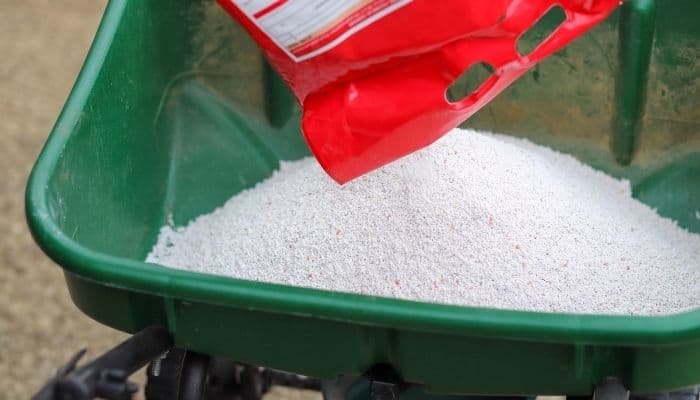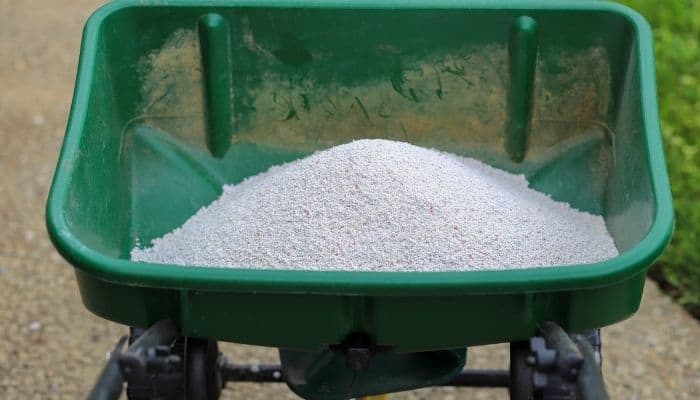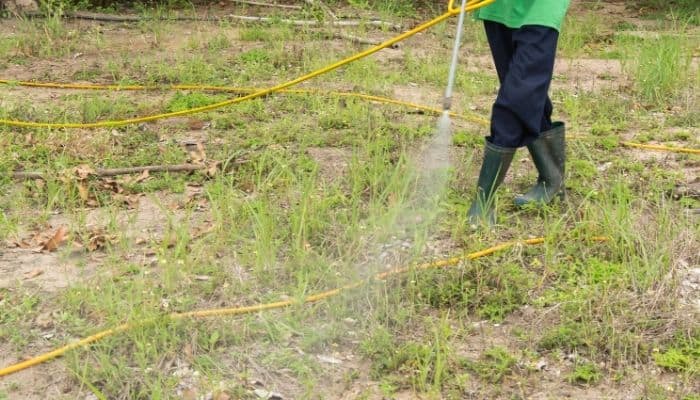Bermuda grass is widely used in lawns and golf courses as it can thrive in harsh conditions.
Maintaining a perfect lawn is not an easy task. It requires your attention to detail and lots of patience. Over the years I’ve seen some of my neighbors struggle to grow a uniform Bermuda grass lawn.
There can be many reasons why it’s not spreading as it’s supposed to be. Let’s look at some of ’em!
Why is my Bermuda not spreading?
- Bermuda grass can’t tolerate shaded areas (Oaktree shade/Garden shed shade etc.). It grows best in full sun.
- Overwatering might be the culprit, which can be overcome by installing a “french drainage” in the lawn.
- Maybe it’s too early? Bermudagrass seeds take a week to a couple of weeks to germinate and a couple of months to spread perfectly.
- Another reason may be the unsettled soil, so give it some time.
- Not enough fertilizer. You need to use a good amount of fertilizer to see the desired results.
- You may have bagged instead of scalping for the first spring mow.
- Not enough water? You need to water your bermudagrass seeds daily 3-4 times! Your new lawn needs 1/2 inch of water every day.
- Some kind of weed might be intervening with bermudagrass.
- Bermuda grass is a southern grass, are you of the north(or Florida)? If yes, then choose an alternative for your lawn.
These might be the reasons why your bermudagrass is not spreading. You need to find what you’re dealing with before taking the right measure. Now let’s see how you can make your lawn greener and better.
How do I get my bermudagrass to spread thicker and greener?
Caring for bermudagrass is easy and that’s why it is seen in so many lawns across the US. Let’s look at some measures which help bermudagrass grow thicker and greener.
How often to water Bermudagrass?
Bermudagrass doesn’t need much water. It just needs enough to survive. Some people say 3 times a week is working for them. For others, it’s every other day.
If there has been no rain for 4-5 days and no forecast of rain for the next 2 days, I water the lawn. I run my sprinklers on manual.

Also, if you need to water your flower beds twice than usual, water the lawn! This kinda works for me always.
I use sprinklers on my lawn and there’s this strategy I follow which ensures they get just the amount of water they need.
I have sprinklers on either side of the lawn. I turn them on alternatively(each side for 10 minutes) so that the other side has enough time to sink in water.
I do this for 30 minutes, as I have a slopy lawn. I use the lower sprinklers twice.
Lack of water doesn’t kill your grass. The grass will just become brown as it goes dormant and it will recover as soon as it gets some water/rain.
Does sand help Bermuda spread?
Sand does not help bermudagrass grow, but it will help it to spread quicker than on soil. Some people use sand to fill in bare spots.
I do not recommend using it though, as it gets hot during the daytime. It allows moisture to escape and it doesn’t actually enhance the growth of bermudagrass.
What is the best fertilizer for Bermudagrass?
Bermudagrass feeds on fertilizer. It needs a good supply of nitrogen, phosphorous, potassium to thrive and spread evenly.
You should be using a fertilizer that has 4 parts nitrogen, 1 part phosphorous, and 2 parts potassium. You may come across many people who argue that phosphorous causes soil pollution.
I disagree. It gets absorbed by the grass. You just need to make sure not to over-feed your grass with phosphorous.

In the spring it’s important that you feed your lawn with fertilizer often(fortnightly). Do not overspray the mixture, spray a lil’ but spray often!
After spring, you can spray once per 4 weeks or 6 weeks and slowly move on to granular fertilizer. This has always worked for me.
Can you fertilize bermudagrass in the summer?
Yes, you can fertilize bermudagrass lawn in the summer. It’s better to use both liquid lawn cover and fertilizer granules simultaneously.
Liquid lawn cover nourishes your lawn instantly while the granules take some time to be absorbed by the bermudagrass.
Use them both as per instructions, use 50% of the specified amount on your lawn. This mixture makes sure your lawn stays green the whole summer.
You’ll notice some results the very next day. Your lawn becomes healthier than it was ever before!
How often should you fertilize bermudagrass?
As said before, you may need to fertilize your lawn every 4 to 5 weeks. This ensures your lawn gets just enough nutrients to thrive.
Granular fertilizer takes many days to sink into the bermudagrass and supplies nutrients for weeks!

Why is my bermudagrass patchy?
Brown spots/burnout patches are seen in many lawns and they look ugly. These spots appear prominently in the first weeks of summer and the good news is, this is when you can find weaker sections in your lawn.
There’s usually some kind of obstruction beneath that brown spot. Usually, it is rocks, root systems of other plants, or some kind of debris.
How to get rid of brown spots?
Many people replace that debris-filled soil with fresh soil and this does the job well. But trust me, it takes a lot of time and effort.
This is when aeration comes in handy. If you have a couple of brown spots here and there, you can do it with a fork. If you have a lot of burn spots, use an aerator.
After aerating that brown spot well, we are ready to move to the next step.
Topdressing! You can use garden soil for topdressing. Spread it evenly on the brown spot using a rake. Do not add more than 1/4th inch of the layer at a time. You can do it a couple of times if that brown spot needs it.
There’s another way to treat bare spots. You can use grass plugs. Install the grass plugs and topdress it adequately with garden soil.
Give it light doses of CarbonX weekly. Mow the area once every two days. You should be seeing results in weeks and your brown spot will fill up in 2 months.
You might see some uneven growth of grass, it gets evened out eventually.

How often should you mow bermudagrass?
Mowing your lawn regularly keeps fungi and rot away. But, how often should you mow your lawn?
Bermudagrass should be mowed weekly and once in two or 3 weeks when your lawn is drought-stressed. Just try to keep the grass height below 2 inches as if it grows taller, it will have fungi/rot issues.
What height do you cut bermudagrass?
You would want your bermudagrass below an inch or two. Do not cut it too short, if you do you might face scalping issues. Scalping issues are usually attributed to an uneven surface.
You just need to make sure your bermudagrass stays below 2 inches. Anything more than 2 inches would be inviting fungus.
How do I keep weeds out of my Bermudagrass?
One of the worst things to happen to a lawn is weed intrusion. You can prevent it. If you already have the problem you can also get rid of the weeds, let’s talk about weeds.
How to prevent weeds in Bermudagrass?
You might wanna use pre-emergent thrice a year on your bermudagrass. Some fertilizers have pre-emergent properties too.
Using pre-emergent will stop weeds from sprouting and spreading in your lawn. Most pre-emergents are granular, so water your lawn with 1/2 inch after treating it with pre-emergent (unless otherwise stated on the bag).
By doing this you make sure the pre-emergent sinks into the soil. This creates a chemical barrier that stops the growth of weedlings.
Do not aerate, cultivate the lawn for a couple of days, if you do you will be disturbing the chemical actions of the pre-emergent.
A single such application of pre-emergent will guard your lawn for 2-3 months depending on the temperature and rainfall.
Let’s see how to get rid of existing weeds from your lawn.
How to get rid of weeds in Bermudagrass?
You can manually pull out weeds, but it only works if there are not many weeds.
There’s another way. Using post-emergent weed killers. This is the fastest and easiest way to kill those weeds which already are thriving.

Before actually spraying the weed killer, assess your situation. Make a map of your lawn and identify zones depending on the type of weeds.
If you zone it out, you’ll know which parts of your lawn need spot spraying and which of them need blanket spraying of the post-emergent.
Read the user manual for each post-emergent and use them accordingly. You should be using weed spray dye when spot spraying as it lets you know which weeds of your lawn got treated with the weed killer.
Here are two common weeds that thrive in bermudagrass and ways to get rid of them.
How to get rid of nutsedge?
Nutsedge loves water. So, it usually grows in those areas of your lawn where water is likely to accumulate(low-lying areas).
Image nutsedge-specific herbicide works the best in my experience. This is super easy to apply and it comes with a nozzle, so you don’t need extra equipment for this.
How to get rid of crabgrass in your bermudagrass lawn?
You shouldn’t be spraying your entire lawn just to get rid of some crabgrass in the lawn(especially in the summer). You also can’t spot spray, I’ll tell you why.
Crabgrass is hydrophobic. So spraying the herbicide directly won’t work well in this case. Let me tell you how I do it.
Get an old cotton t-shirt, wrap it at the end of a light-weight pole/rod. You need to drench this in the herbicide thoroughly.
Now wherever you see crabgrass, just rub it using this “t-shirt rod”. This makes sure the herbicide actually gets absorbed by the crabgrass. The crabgrass will die in a week of application.
This is a very good way to do it as you won’t be spraying your bermudagrass or flowerbeds while also keeping your lawn safe for pets.
My advice to you is to observe your lawn and do what needs to be done at the right time. Mow, feed, water your lawn regularly.
That’s it, folks! I wish you a greener, thicker and weed-free bermudagrass lawn : )))

